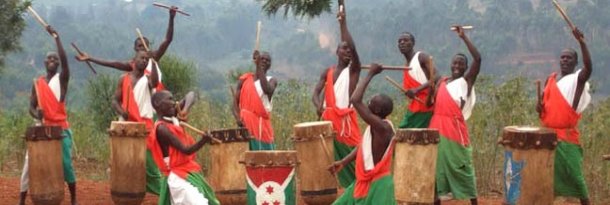|
Organisations such as UNICEF and other NGOs have used the tradition of Burundi drumming to help heal the ethnic divisions that erupted into Burundi's savage civil war. By getting children to play the drums as part of a team they are showing that by working together much can be achieved whilst simultaneously celebrating the country's heritage. The sound and power of the drumming also served to promote the person as a drummer rather than a person of Hutu or Tutsi ethnicity.
 If you are interested in the heritage and culture of Burundi Drumming the Gishora Drums Sanctuary just four miles outside Burundi's new capital city of Gitega is well worth a visit. The sanctuary was opened in 1989 and commemorates an event in 1900 when King Mwezi IV Gisabo of Burundi (1840 - 1908) fled usurpers who had sided with the Germans after their occupation of the country and hid in Gishora. In his will he left two drums that he had made from cow skin to the people who had helped him and today the Drums Sanctuary offers exhibitions of dancing and drumming by the very descendants of those who had helped the king. The site is currently on the UNESCO World Heritage Tentative List. If you are interested in the heritage and culture of Burundi Drumming the Gishora Drums Sanctuary just four miles outside Burundi's new capital city of Gitega is well worth a visit. The sanctuary was opened in 1989 and commemorates an event in 1900 when King Mwezi IV Gisabo of Burundi (1840 - 1908) fled usurpers who had sided with the Germans after their occupation of the country and hid in Gishora. In his will he left two drums that he had made from cow skin to the people who had helped him and today the Drums Sanctuary offers exhibitions of dancing and drumming by the very descendants of those who had helped the king. The site is currently on the UNESCO World Heritage Tentative List.
Burundi music itself has a rich earthy sound and has been used by the likes of Malcolm McLaren to pioneer the early Adam and the Ants sound. It has been claimed that every Burundian is a musician at heart with a soul likened to a taut string that vibrates at the slightest breeze. Music flows very naturally in Burundi especially at family gatherings when song erupts spontaneously and all those present join in the 'uruvyino' or mass singing and hand clapping and dancing soon follows. The video (below, right) featuring Burundi music is typical of the style of music, fresh and real without the structure associated with much western music. The music's lyrics normally reflects what's on the mind of the singers as they perform and drum, making it music from the heart and soul. Traditional Burundi music, especially that from the old Kingdom, is both very simple but simultaneously mesmerising. Music from Burundi gained wider exposure in part due to the conflict there as many Burundi people fled to Belgium who ran the colony in colonial times. Burundi Belgian musicians such as Khadja Nin, a former member of the Burundi Bujumbura choir, and Ciza Muhira have released critically acclaimed albums.
|

 If you are interested in the heritage and culture of Burundi Drumming the Gishora Drums Sanctuary just four miles outside Burundi's new capital city of Gitega is well worth a visit. The sanctuary was opened in 1989 and commemorates an event in 1900 when King Mwezi IV Gisabo of Burundi (1840 - 1908) fled usurpers who had sided with the Germans after their occupation of the country and hid in Gishora. In his will he left two drums that he had made from cow skin to the people who had helped him and today the Drums Sanctuary offers exhibitions of dancing and drumming by the very descendants of those who had helped the king. The site is currently on the UNESCO World Heritage Tentative List.
If you are interested in the heritage and culture of Burundi Drumming the Gishora Drums Sanctuary just four miles outside Burundi's new capital city of Gitega is well worth a visit. The sanctuary was opened in 1989 and commemorates an event in 1900 when King Mwezi IV Gisabo of Burundi (1840 - 1908) fled usurpers who had sided with the Germans after their occupation of the country and hid in Gishora. In his will he left two drums that he had made from cow skin to the people who had helped him and today the Drums Sanctuary offers exhibitions of dancing and drumming by the very descendants of those who had helped the king. The site is currently on the UNESCO World Heritage Tentative List.






